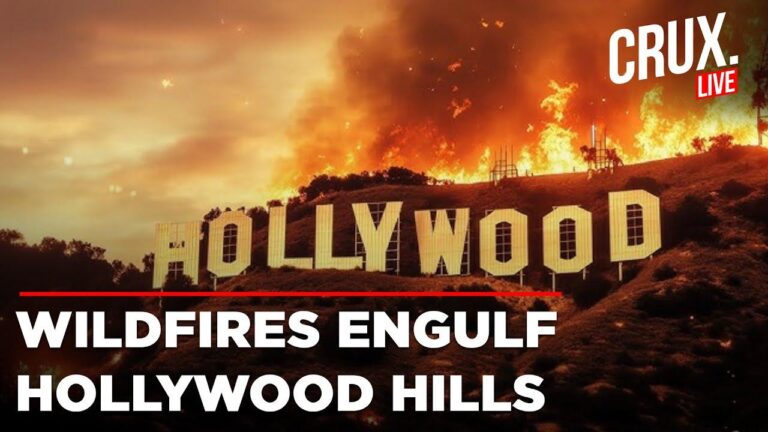Rapidly Escalating Hollywood Hills Wildfire Amid Los Angeles Fire Crisis
A swiftly advancing wildfire has ignited in the Hollywood Hills, intensifying the already critical wildfire emergency sweeping across Los Angeles. Fueled by persistent drought, soaring temperatures, and gusty winds, the blaze threatens numerous homes and has prompted urgent evacuation orders in several neighborhoods. Thick plumes of smoke have darkened the skies, while utility companies are working to mitigate power disruptions caused by the fire’s proximity to key infrastructure.
Fire officials highlight that the combination of strong winds,extremely low humidity,and dry vegetation has created a volatile environment,exacerbating fire behavior and complicating containment efforts. Hundreds of firefighters, supported by aerial tankers and helicopters, are engaged in aggressive suppression tactics. Despite these efforts, the fire’s growth remains a notable concern as weather conditions continue to favor rapid spread. Evacuation centers are fully operational, and residents are strongly advised to monitor official updates closely.
- Evacuation zones: Laurel Canyon, Beachwood Canyon, Griffith Park area
- Firefighting personnel deployed: More than 350 firefighters and 20 aircraft
- Containment progress: Approximately 15% containment as of early Wednesday
| Condition | Current Measurement | Effect on Fire |
|---|---|---|
| Wind Velocity | 20-35 mph | Accelerates fire expansion |
| Relative Humidity | 10% | Dries out vegetation, increasing flammability |
| Temperature | 95°F (35°C) | Heightens ignition potential |
Coordinated Firefighting Operations Address Multiple Wildfires in Urban and Wilderness Areas
Firefighting teams throughout Los Angeles County are actively engaged in battling several concurrent wildfires affecting both densely populated neighborhoods and remote mountainous regions. The unpredictable wind shifts, rugged terrain, and limited access routes have posed significant obstacles to containment efforts. Emergency management agencies have escalated response levels, integrating aerial and ground resources to safeguard thousands of residences and vital infrastructure. Evacuation mandates remain in effect for high-risk zones, with numerous shelters established to accommodate displaced individuals.
Core components of the firefighting strategy include:
- Helicopter and fixed-wing aircraft water and retardant drops to suppress advancing flames
- Ground teams executing controlled burns and constructing firebreaks to halt fire progression
- Real-time surveillance using drones and satellite technology to monitor fire behavior and spread
- Community outreach through emergency alerts and evacuation support services
| Fire Location | Acres Affected | Containment Level | Evacuations Issued |
|---|---|---|---|
| Hollywood Hills | 1,200 acres | 40% | 3,500+ residents |
| Santa Clarita | 950 acres | 35% | 2,000+ residents |
| San Gabriel Mountains | 1,750 acres | 25% | 1,200+ residents |
Residential Impact and Expanding Evacuations as Wildfires Threaten Critical Infrastructure
Communities within the Hollywood Hills and adjacent neighborhoods are confronting escalating threats as the wildfire encroaches on populated areas. Authorities have mandated evacuations affecting over 4,000 homes, urging residents to evacuate promptly to ensure their safety. The dense smoke and unpredictable wind patterns have further hindered firefighting operations, raising alarms about the vulnerability of essential infrastructure such as electrical grids, water supply lines, and major transportation routes.
- Evacuation orders now encompass more than 4,000 residences
- Temporary shelters established at local schools and community centers
- Emergency personnel conducting door-to-door evacuation notifications
- Increased deployment of aerial firefighting units and ground crews
| Neighborhood | Evacuations Ordered | Infrastructure at Risk |
|---|---|---|
| Hollywood Hills West | 2,200 homes | Electric power grid, major roadways |
| Laurel Canyon | 1,100 homes | Water mains, communication lines |
| Studio City | 700 homes | Gas pipelines, local highways |
Proactive Safety Measures for Residents in Wildfire-Prone Areas
Individuals residing in wildfire-vulnerable regions should prioritize the removal of dry brush, dead leaves, and other flammable materials within a minimum 30-foot perimeter around their homes to establish defensible space. Regular trimming of trees and shrubs is essential to reduce potential fire fuel.Community initiatives,such as neighborhood clean-up events and the formation of fire-safe councils,can significantly bolster collective preparedness and maintenance of fire-resistant landscapes.
Utilizing fire-resistant construction materials—such as Class A rated roofing, tempered glass windows, and non-combustible siding—can greatly improve a home’s resilience against wildfire exposure. Equally vital is the growth and rehearsal of extensive evacuation plans, including identifying multiple escape routes and establishing reliable communication methods to stay updated during emergencies. Additional recommended precautions include:
- Installing ember-resistant vents to prevent airborne embers from infiltrating attics or crawl spaces.
- Maintaining emergency supply kits stocked with essentials like water, medications, important documents, and protective gear.
- Regularly inspecting and servicing firefighting equipment such as hoses, fire extinguishers, and pumps to ensure readiness.
Conclusion: Ongoing Efforts and Public Advisories
As the wildfire in the Hollywood Hills continues to challenge firefighting resources amid a broader regional emergency, officials remain steadfast in their mission to contain the flames and safeguard communities. With conditions still volatile and resources stretched, authorities urge residents to stay vigilant, comply with evacuation directives, and rely on official communication channels for the latest updates. The situation is evolving rapidly, and continued cooperation between emergency responders and the public is critical to mitigating the impact of this severe wildfire season.




